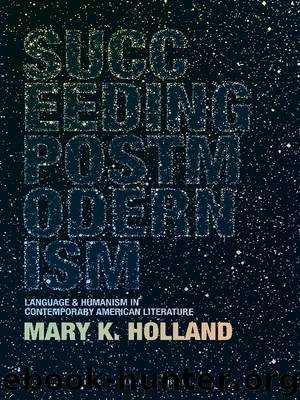Succeeding Postmodernism by Holland Mary K.;

Author:Holland, Mary K.;
Language: eng
Format: epub
Publisher: Bloomsbury Publishing
Published: 2012-03-18T16:00:00+00:00
Remediation as “working through” to grief
In the same way that multiple acts of mediation redeem each individual act, the novel’s all-encompassing context of narrative remediation recuperates individual narrative strategies. One of the strategies redeemed by its containment within the House’s matrix of mediation is the psychoanalytic process of “working through” that leads the trauma victim out of the repetition compulsion of melancholy and into the recuperative process of grief. Whereas the Navidson family (and Zampanò’s academic analysis of it) demonstrates the process of recuperation of emotion and familial bonds through remediation of inscription technologies, Johnny Truant’s reconstruction of Zampanò’s text—in which the “monster” in the labyrinth becomes the mother he has lost but has been unable to grieve—depicts recuperation of a traumatic past through his own psychoanalytical remediation of that story. For Johnny, this traumatic understanding, generated through the same process of remediation that unites the Navidson family, becomes an essential part of his ability to come to terms with loss and so remember the mother whom trauma had obliterated. By integrating Johnny’s psychoanalytical process of working through so thoroughly into the mediation matrix that defines the novel, Danielewski legitimizes this recently maligned metanarrative as a valid meaning-making method even within our postmodern culture.
Johnny’s footnotes to The Navidson Record create a virtual blueprint to Freud’s theories of “working through” traumatic experience to escape the trap of melancholy and emerge into conscious, healing grief. In his “Remembering, Repeating, and Working Through” (1914), Freud recommends psychoanalysis as a technique for making unconscious memories of traumatic experience conscious so that victims of trauma can break free from the compulsion to repeat traumatic experience as a substitute for conscious memory. Key to recognizing elements of this unconscious traumatic memory are the victim’s dreams, which (Freud asserts here and throughout his writing) contain experiences, often from childhood, that have been neither forgotten by the patient nor consciously understood. Key to making these experiences conscious and so understanding them is transferring the unconscious memories into a conscious realm that is separate from and so safe for the self. Freud focuses on the patient’s transference of his or her unconscious feelings onto the analyst, who may then make them conscious so that the patient can “work through” these now-conscious resistances to memory.29 Johnny transfers his unconscious trauma onto his reading of The Navidson Record in a similar act of self-alienation from unbearable emotion that leads to self-understanding.
Johnny’s exploration of his traumatic past through reconstructing The Navidson Record demonstrates recuperation by becoming conscious specifically of grief. One year after publishing “Remembering, Repeating, and Working Through,” Freud extends his theory of working through unconscious suffering to the crippling experience of melancholy by identifying the problem of melancholy as that of unconscious suffering of loss that must be consciously worked through (“Mourning and Melancholia,” 1917). In this account, he describes melancholy as a reaction to the loss of a loved one resulting in “a profoundly painful dejection, cessation of interest in the outside world, loss of the capacity to love,
Download
This site does not store any files on its server. We only index and link to content provided by other sites. Please contact the content providers to delete copyright contents if any and email us, we'll remove relevant links or contents immediately.
| African | Asian |
| Australian & Oceanian | Canadian |
| Caribbean & Latin American | European |
| Jewish | Middle Eastern |
| Russian | United States |
4 3 2 1: A Novel by Paul Auster(11047)
The handmaid's tale by Margaret Atwood(6852)
Giovanni's Room by James Baldwin(5877)
Big Magic: Creative Living Beyond Fear by Elizabeth Gilbert(4723)
Asking the Right Questions: A Guide to Critical Thinking by M. Neil Browne & Stuart M. Keeley(4574)
On Writing A Memoir of the Craft by Stephen King(4213)
Ego Is the Enemy by Ryan Holiday(3991)
Ken Follett - World without end by Ken Follett(3972)
The Body: A Guide for Occupants by Bill Bryson(3800)
Bluets by Maggie Nelson(3709)
Adulting by Kelly Williams Brown(3669)
Guilty Pleasures by Laurell K Hamilton(3586)
Eat That Frog! by Brian Tracy(3514)
White Noise - A Novel by Don DeLillo(3434)
The Poetry of Pablo Neruda by Pablo Neruda(3366)
Alive: The Story of the Andes Survivors by Piers Paul Read(3310)
The Bookshop by Penelope Fitzgerald(3225)
The Book of Joy by Dalai Lama(3217)
Fingerprints of the Gods by Graham Hancock(3212)
